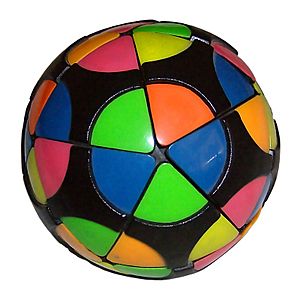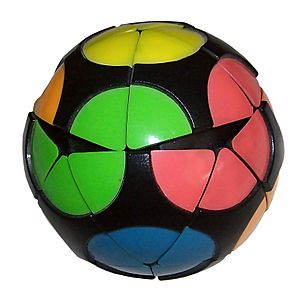Impossiball facts for kids
The Impossiball is a cool puzzle shaped like a rounded ball. It's a bit like a Rubik's Cube, but it's round! This puzzle has 20 pieces that you can move around. All of these pieces are like the corner pieces you'd find on a Pocket Cube.
Contents
What is the Impossiball?
The Impossiball looks like a ball, but it's actually shaped like a special 20-sided object called an icosahedron. Imagine a shape with 20 flat faces, and then make it smooth and round like a sphere. That's the Impossiball!
It has 20 pieces, and every single one is a corner piece. There are 12 circles on the puzzle, placed at the points of the icosahedron. If you have the six-color version, the circles on opposite sides of the puzzle will have the same color. Because the puzzle is round, the pieces lift up and down a little when you turn them. You can even take one piece out to make it like a round version of the 15 puzzle.
How do you play the Impossiball?
The main goal of the Impossiball is to mix up all the colors and then put them back in order. When it's solved, each circle should have only one color. This puzzle is similar to solving just the corner pieces of a Megaminx puzzle.
The first Impossiball puzzles had the same colors as a standard Rubik's Cube: red, orange, yellow, green, blue, and white. Today, you can find two main types. One has six colors, and the other has twelve. The six-color version (like the one in the pictures) uses pink, two shades of orange, yellow, green, and blue. Even if two pieces have the same three colors, you can still tell them apart because they are mirror images of each other. The twelve-color version has many more shades, including red, pink, orange, yellow, different greens, blues, purple, brown, and white.
How to Solve the Impossiball
Even though the Impossiball looks tricky and has many possible ways to mix up the pieces, it's not much harder than a Pocket Cube (the 2x2x2 Rubik's Cube). This is because it's not a "deep-cut" puzzle. It only has layers that turn in a pentagon shape, which are similar to the square layers on a regular cube.
Many of the ways you solve a Pocket Cube can also be used to solve the Impossiball. If you know how to solve a Pocket Cube, you're already on your way to solving this cool spherical puzzle!
How Many Combinations?
The Impossiball can be mixed up in a huge number of ways! There are about 23,563,902,142,421,896,679,424,000 different ways to arrange its pieces. That's a really, really big number! To give you an idea, it's roughly 23.6 septillion in the short scale (which is used in places like the US) or 23.6 quadrillion in the long scale (used in places like Europe).
See also
 In Spanish: Impossiball para niños
In Spanish: Impossiball para niños




